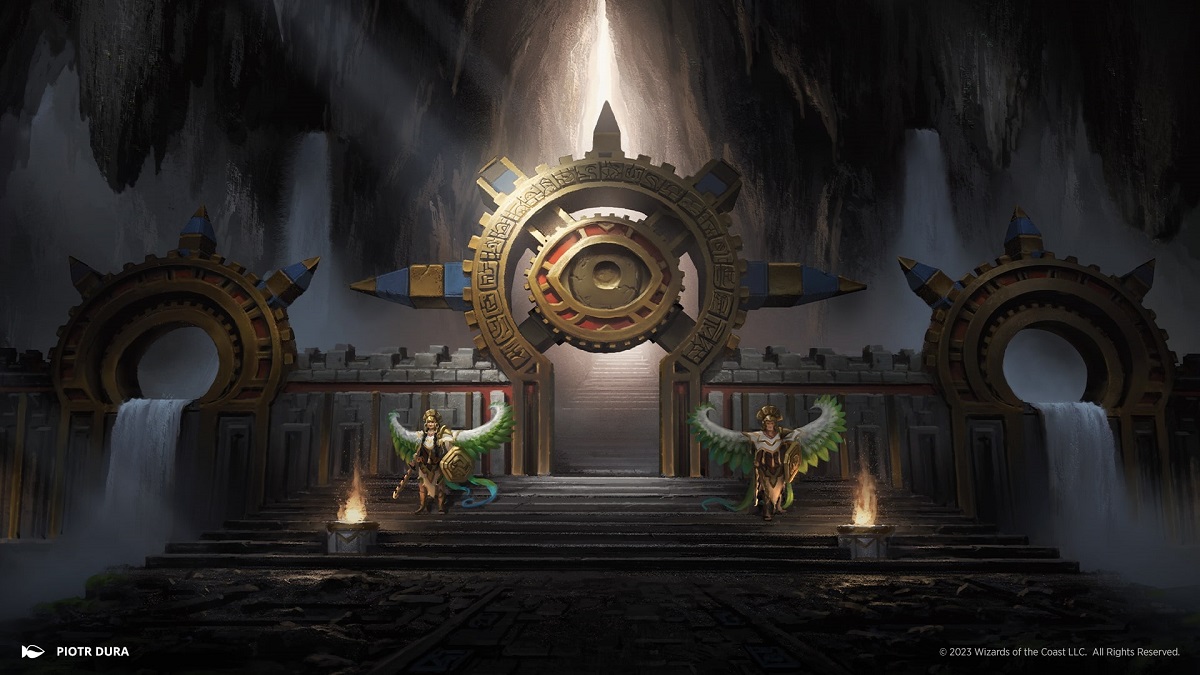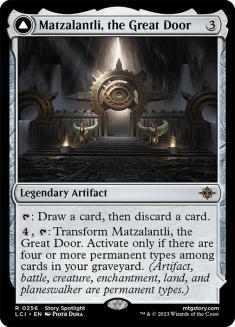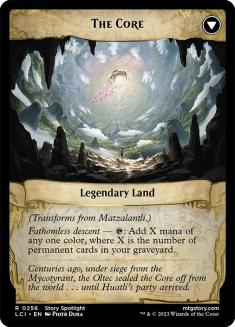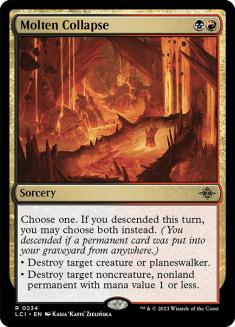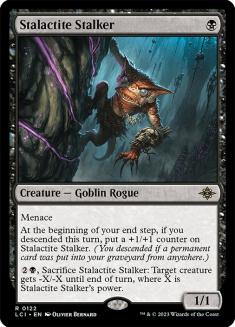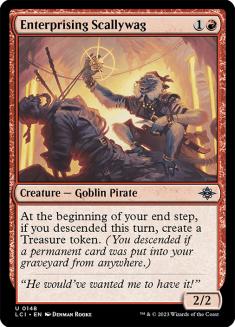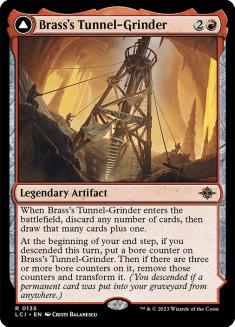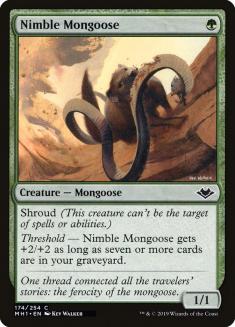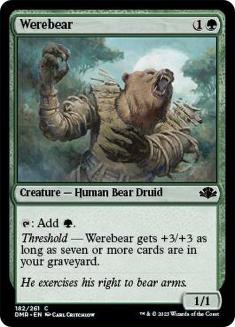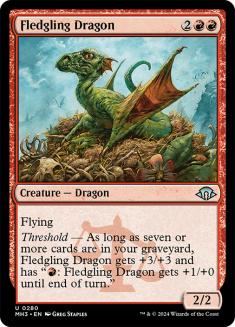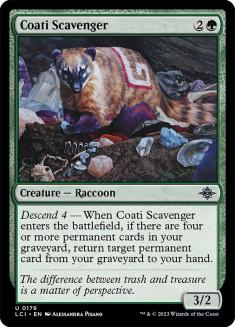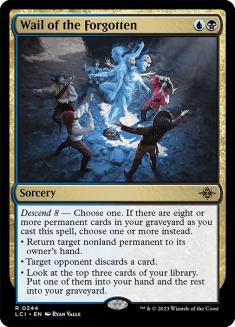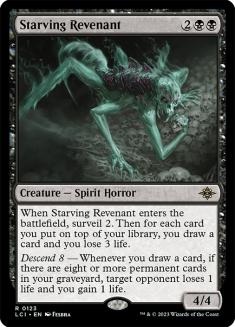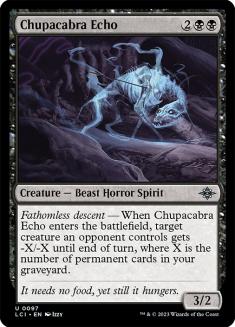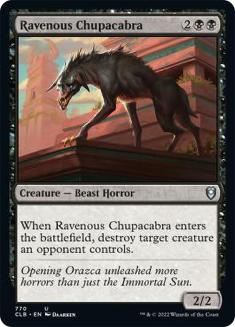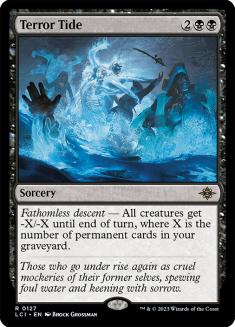Howdy, gamers! This article is appearing on the first of November, but I’m writing it on Halloween, which ranks among my favorite holidays. Costumes, candy, and the last opportunity for celebration before the weather gets too cold in Minnesota to want to leave the house much at all – there’s a lot to like. While the spooky season has officially ended, we do have a new Magic set with some heavy graveyard themes on the horizon in The Lost Caverns of Ixalan, and it only makes sense to me to talk about graveyard mechanics in Cube!
The ability to make use of the graveyard can offer a serious fundamental advantage to one deck over another. Whether this happens by Reanimating a creature for less mana than its intended mana value, assembling an incidental army through dredging, recurring cards for value, or even just counting them for a payoff like Spider Spawning, there are tons of examples in Magic’s history of ways to gain an advantage by caring about your graveyard. Successful graveyard strategies tend to rely on at least one of three things. They are some combination of easy to set up, worth jumping through some hoops for, or just reasonable to play when you can’t set up your graveyard. Today I’ll be evaluating some of the cards and mechanics we’ve seen previewed from The Lost Caverns of Ixalan through this lens.
Matzalantli, the Great Door
The first card I want to talk about is Matzalantli, the Great Door. My Spooky Cube proudly displays myriad graveyard synergies, and Matzalantli stood out to me immediately as doing a lot of things that Spooky Cube cares about. It’s a madness enabler, with discard outlets filling the graveyard otherwise, and it has something of a graveyard payoff. Unfortunately, the transform ability is just a mana sink that turns into more mana. I was hoping for something flashier, but the card as printed provides a good example of a graveyard-matters card that relies strongly on being good enough even when you’re not fully committed to the graveyard.
Let’s talk about the other criteria for success with graveyard strategies first. Is Matzalantli’s transform ability easy to set up? No! Not remotely. A casual read might make you think it’s just the same thing as delirium, but the card actually only cares about permanent types. Instants and sorceries tend to be pretty important card types for delirium, given that they naturally put themselves in the graveyard when you cast them. It’s not all that difficult to get a creature and a land in your graveyard, but then you have to first have in your deck and then get two of planeswalker, artifact, enchantment, and battle into the bin. The discard ability provides a relatively easy avenue to accomplish this, but in actual games, you’ll often find yourself discarding the third and fourth land before you consider discarding any spells.
As for whether the payoff is worth it, that’s actually where the card falls the most flat. The setup is difficult but not impossible, but then you have to pay a rather steep mana cost just to get a land that taps for mana, which also causes you to lose the looting ability! If you’re looking at the backside, it’s likely you’re playing Commander.
The glimmer of hope for Matzalantli is that looting is a powerful ability to have access to every turn, which means that even when your deck has no ability to transform the card, it’s still a reasonable card to cast and permanent to control. It’s weaker than a Merfolk Looter in that it doesn’t come with a body, but this also comes with the fact that it can’t be hit by creature removal. Looting effects on artifacts like this tend to cost mana to activate, so there is something to like here, even if The Core is disappointing. A three-mana card that loots every turn offers just enough for me to try it in Spooky Cube, though admittedly if you’re not taking advantage of other discard or graveyard synergies, there are plenty of more efficient and powerful ways to churn through your deck.
Descending
Descending is a new thing to care about in The Lost Caverns of Ixalan, and it’s more or less an easier-condition-to-meet version of revolt that is also more graveyard-centric. Unlike revolt, it won’t work with tokens, but it cares about enough other things to make up for this. Cueing off any permanent type and caring about permanent cards entering the graveyard from any zone makes descending a trivial condition to meet with creatures trading in combat, looting, self-mill, and everyone’s favorite enabler: fetchlands. While Matzalantli, the Great Door exists more in the enabler space, cards that care if you descended will generally be payoffs.
Some cards like Molten Collapse occupy space similar to Fatal Push that can seamlessly show up in environments without much of anything happening in the graveyard, which is what you can expect from instants and sorceries with mechanics like this. Cards like Enterprising Scallywag and Ruin–Lurker Bat, on the other hand, allow you to build an engine around cards entering your graveyard turn over turn.
Cards that care whether you descended occupy space where they’re quite easy to facilitate, and these cards will mostly live on the merit of how powerful they are in normal games of Magic. Descending is a condition you can expect to regularly meet in most environments, but the mechanic will mostly show up in Cubes on otherwise playable cards. It’s not difficult to descend and choose both modes on Molten Collapse, but for the most part, I expect to see it in Cubes that would have used Dreadbore otherwise.
Cards like Stalactite Stalker and Enterprising Scallywag give you more to think about by scaling over time, but they still ask the same base question. If you’re not all that interested in black aggressive creatures in your Cube, then a one-mana 1/1 isn’t going to cut it, and Enterprising Scallywag is likely only showing up if your Cube isn’t trying to facilitate strictly aggressive decks. Especially on cards that only trigger once a turn, the base rate really matters when it comes to determining whether these cards can hang. That said, in less traditional environments, a one-mana 1/1 and a two-mana 2/2 are plenty efficient bodies to start building an engine around. The relevant hoop here is more the rate of other creatures available and the ability to wait multiple turns for your payoff.
Brass’s Tunnel-Grinder is among the more interesting cards that cares about descending previewed so far, largely because it has a card-neutral ability that is likely to give you the first bore counter. Transforming into a land is quite powerful, as we’ve learned from cards like Treasure Map and Legion’s Landing, and discovering when you cast permanents is quite powerful as well. The question here mostly has to do with whether you can spend three mana at sorcery speed to not impact the battlefield. That’s a tough ask in Vintage Cube, but is much more manageable in other environments. I know I’d pick this card highly in Live the Dream Cube!
Descend 4, Descend 8, and Fathomless Descent
And then we have cards with descend 4, descend 8, and fathomless descent, which care not about what happened this turn, but rather what’s happening in this game. These mechanics function similarly to threshold and undergrowth, and generally have more difficult conditions to meet than merely descending, in addition to appearing on cards that care more about doing so.
Threshold is an old favorite mechanic of mine, and is a great comparison point for these descend abilities. In Eternal formats, it’s not terribly difficult to enable threshold. With fetchlands, cantrips, and the efficient interaction that shows up in these formats it’s pretty easy to get seven cards in your graveyard. Descend changes that equation though, by caring specifically about permanent cards. Fetchlands still play, but Ponder and Lightning Bolt aren’t going to help here. At least not directly. I’ve always said that if you don’t love Nimble Mongoose as a 1/1 then you don’t deserve it as a 3/3, but the increased difficulty in getting permanents into your graveyard over just cards means that it will be even more important for cards with descend to be playable before you meet their conditions than their threshold counterparts.
Coati Scavenger is a great card to consider when evaluating descend 4. When you meet the card’s condition, it has some give and take with Eternal Witness, though is generally a slightly weaker card, and when you don’t meet the condition, the card is not worth casting. There’s room to be weaker than Eternal Witness and still be plenty playable in a Peasant Cube, but that’s really only true if that’s true of the card’s floor, not its ceiling.
Descend 4 requires enough permanents that your deck has to be constructed with the ability in mind to reliably hit it before Turn 5 or so, and it’s really not worth it to try to get a three-drop’s worth of value on Turn 5 in most environments. It’s not a difficult hoop to jump through, but it’s not a trivial one either, and as such, the value of the card when you don’t meet the condition matters a lot. A good card with descend 4 really needs to be above rate before meeting the requirement, after doing so, or both. I like that Coati Scavenger is a value-generating ability, as compared to Akawalli, the Seething Tower, which is only good for attacking and blocking, but the rate still just isn’t there.
Descend 8 is a harder ability to set up, which makes it even easier to evaluate abstractly. You can imagine hitting descend 4 somewhat incidentally in the average game of a lot of Cubes. Unless those games are going very long or you’re really working for it, this is not true of descend 8. It might seem at a glance that descend 8 is only twice as difficult to enable as descend 4, but once you think about it, it’s actually more difficult than that.
Let’s say you’re playing retail Limited. It will be fairly common to have two to four creatures in your opening hand, which over the natural course of the game will enable you to establish descend 4 without too many draw steps. Well, you got those cards from drawing your opening seven card hand. You don’t get to draw seven fresh ones on turn two, so it takes a lot longer through naturally drawing to get from four to eight. If you’re not looting and milling, it’s just not going to happen, so cards with descend 8 need to do something really dramatic and/or find their way into decks that are very efficient at filling their graveyards.
Some cards, like Wail of the Forgotten, are worth considering because they’re more or less worth casting without hitting descend 8. Even still, the card is generally weak as anything other than a graveyard enabler if you don’t have descend 8 online. It’s quite strong if you can hit that threshold, which is why it’s nice that it itself can function as an enabler, because you won’t want to play this card in a Cube without a significant graveyard theme.
Starving Revenant is another example of what a playable card for 40-card formats with descend 8 looks like. The card generates some value when it enters the battlefield one way or the other at a solid rate and then gives you a little bonus if you’ve hit descend 8. Most of the value of the card comes upfront, and you really don’t get your money’s worth for jumping through the hoops to descend 8, but some card filtering or outright card advantage on a four-drop is pretty powerful in and of itself. The card is considerably weaker than something like Sheoldred, the Apocalypse or Yawgmoth, Thran Physician, but it can definitely hang in lower-powered Cubes and is a shoo-in for Spooky Cube.
Finally, we come to fathomless descent, which just tracks the total number of permanent cards in your graveyard. It won’t be difficult to get one or two permanents in your graveyard without much trouble, but consistently hitting four or more will take some work, as I’ve previously established. Cards with this ability mostly will be contingent on graveyard support in the environment at large. Compare Chupacabra Echo to Ravenous Chupacabra and you get the picture. I like cards that require a little investment and I would love to draft a Cube which features Chupacabra Echo over Ravenous Chupacabra, but it doesn’t make sense to do so in terms of which card is abstractly more playable.
I’m hoping to see a build-around in the vein of Spider Spawning or Rise from the Tides with fathomless descent, but such a card has not been previewed yet as of this writing. What generally makes sense for the mechanic is to build your entire deck around having permanents in your graveyard, and we haven’t seen any big effects just yet to make doing so worth it because the hoops are pretty significant. Terror Tide is a neat card, but you’ve got to give me something I can’t get from just playing Damnation instead to make me want to build an entire deck.
I like all of the graveyard mechanics appearing in The Lost Caverns of Ixalan, though I’m still waiting on more individual cards to really grab me. The graveyard is a dangerous resource to mess with, so I understand playing it safe, but I’m at least hopeful to see that powerful draft build-around with fathomless descent.

